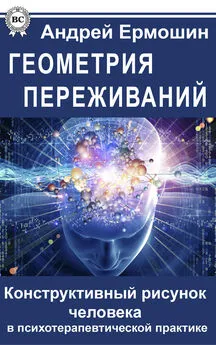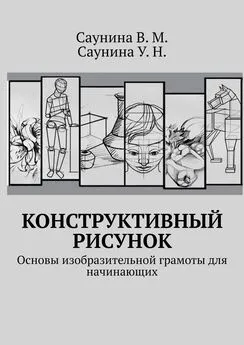Андрей Ермошин - Геометрия переживаний. Конструктивный рисунок человека в психотерапевтической практике
- Название:Геометрия переживаний. Конструктивный рисунок человека в психотерапевтической практике
- Автор:
- Жанр:
- Издательство:неизвестно
- Год:неизвестен
- ISBN:нет данных
- Рейтинг:
- Избранное:Добавить в избранное
-
Отзывы:
-
Ваша оценка:
Андрей Ермошин - Геометрия переживаний. Конструктивный рисунок человека в психотерапевтической практике краткое содержание
Перед Вами – книга известного современного психотерапевта Андрея Ермошина, рассказывающая о возможностях диагностики различных состояний пациента на основании простого теста «Конструктивный рисунок человека».
Рисуночный тест помогает врачу-психотерапевту максимально быстро выявить критические периоды в жизни пациента, требующие тщательной психотерапевтической проработки, предоставляет глубокие возможности для диагностики расстройств здоровья. Практическое применение теста «Конструктивный рисунок человека» во врачебной практике привело автора книги к открытию взаимосвязи графических признаков и синдрома кислородного (энергетического) голодания мозга.
Книга «Геометрия переживаний. Конструктивный рисунок человека в психотерапевтической практике» – бесценное пособие для психотерапевтов, психологов, врачей, а также для всех тех, кто желает помочь себе и окружающим людям избавиться от груза травмирующих переживаний.
Геометрия переживаний. Конструктивный рисунок человека в психотерапевтической практике - читать онлайн бесплатно ознакомительный отрывок
Интервал:
Закладка:
7. Buck J.N. The H-T-P Tecnique: a qualitative and puantitative scoring manual//J. of clin. psychol. 1948 Vol.4 P. 317–396.
8. Burns B., Kaufman, S. (1972). Actions, style and symbol in Kinetic Family Drawing. N.Y.
9. Bussing R., Grudnik J., Mason D., Wasiak M., Leonard C. ADHD and conduct disorder: an MRI study in a community sample. World J Biol Psychiatry 2002; 3(4):216-20.
10. Castellanos F.X., Giedd J.N., Berquin P.C., Walter J.M., Sharp W., Tran T., Vaituzis A.C., Blumenthal J.D., Nelson J., Bastain T.M., Zijdenbos A., Evans A.C., Rapoport J.L. Quantitative brain magnetic resonance imaging in girls with attention-deficit/hyperactivity disorder. Arch Gen Psychiatry 2001; 58: 289–295.
11. Castellanos F.X., Lee P.P., Sharp W., Jeffries N.O., Greenstein D.K., Clasen L.S., Blumenthal J.D., James R.S., Ebens C.L., Walter J.M., Zijdenbos A., Evans A.C., \Giedd J.N., Rapoport J.L. Developmental trajectories of brain volume abnormalities in children and adolescents with attention-deficit/hyperactivity disorder. JAMA 2002; 288 (14): 1740–1748.
12. Castellanos F.X., Sharp W.S., Gottesman R.F., Greenstein D.K., Giedd J.N., Rapoport J.L. Anatomic brain abnormalities in monozygotic twins discordant for attention deficit hyperactivity disorder. Am J Psychiatry 2003; 160: 1693–1696.
13. Dellinger S. Psychogeometrics: How to use geometric psychology lo influence people. New Jersey: Prentice-Hall, 1989.
14. Disney E.R., Elkins I.J., McGue M., Iacono W.G. Effects of ADHD, conduct disorder and gender on substance use and abuse in adolescence. //Am. J. Psychiatry. 1999. V.156. P. 1515–1521.
15. Drevets W.C., Raichle M.E. Neuroanatomical circuits in depression: Implication for treatment mechanisms//Psychopharm.Bull. 1992. Vol. 28. P. 261–274.
16. Durston S., Hulshoff Pol H.E., Schnack H.G., Buitelaar J.K., Steenhuis M.P., Minderaa R.B., Kahn R.S., van Engeland H. Magnetic resonance imaging of boys with attention-deficit/hyperactivity disorder and their unaffected siblings. J Am Acad Child Adolesc Psychiatry 2004; 43(3):332-40.
17. Ermoshin A. «Things in body: new approach to emotional problems», 6-th world congress on «Innovations in psychiatry – 2000». London: 2000. P. 13.
18. Ermoshin Andrei. La Psicocatalisi dei padri che non hanno responsabilita’ // Atti del IV Congresso Internazionale Citta’ di Ascoli Piceno sul tema «… senti?… a proposito del padre e… della sua gravidanza…» – Ascoli Piceno: 2007. – P. 73–77.
19. Ermoshin Andrei. La psicocatalisi ricreativa ed il lavoro con le coppie // Atti del 3 Congresso Internazionale Citta` di Ascoli Piceno sul tema La coppia nel 3 Millennio. Penelope – la Trasformazione della Vendetta. – Ascoli Piceno: 2004. – P. 80–83.
20. Ermoshin Andrey. Things in bodу / Materials of the 2 Panasiatic Congress for psychotherapy. Tokyo: 2006
21. Ernst M., Kimes A.S., London E.D., Matochik J.A., Eldreth D., Tata S., Contoreggi C., Leff M., Bolla K. Neural substrates of decision making in adults with attention deficit hyperactivity disorder. Am J Psychiatry 2003; 160: 1061–1070.
22. Eysenk H.J. (1941). Type factors in aesthetic judgment. British Journal of Psychology, 31, 262–270.
23. Faraone S.V., Perlis R.H., Doyle A.E., Smoller J.W., Goralnick J.J., Holmgren M.A., Sklar P. Molecular genetics of attention-deficit/hyperactivity disorder. Biol Psychiatry 2005; 57: 1313–1323.
24. Flory K., Lynam D.R. The relation between attention deficit hyperactivity disorder and substance abuse: what role does conduct disorder play? Clinical Child and Family Psychology Review 2003; 6 (1): 1-15.
25. Giedd J.N., Snell J.W., Lange N., Rajapakse J.C., Casey B.J., Kozuch P.L., Vaituzis A.C., Vauss Y.C., Hamburger S.D., Kaysen D., Rapoport J.L. Quantitative magnetic resonance imaging of human brain development: ages 4-18. Cerebral Cortex 1996; 6: 551–560.
26. Godenough F. L. Mental Testing. 1949.
27. Godenough F. L. The Measurement of Intelligence by Drawing. 1926.
28. Gottschaldt Kurt Bruno Uber den Einfluss der Erfahrung auf die Wahrnehmung von Figuren, «Psychol. Forsch,» 1926, 8, S. 261–317, 1928, 12, S. 1–87; в рус. пер. Прошлый опыт и организация, в кн.: Хрестоматия по ощущению и восприятию, М., 1975.
29. Gould E., Gross C.G. Neurogenesis in adult mammals: some progress and problems. J Neurosience 2002; 22(3): 619–623.
30. Gray T.S., Carney M.E., Magnusson D.J. Direct projections from the centralamygdaloid nucleus to the hypothalamic paraventricular nucleus: possible role in stress-induced adrenocorticotrophin release//Neuroendocrinology. 1989. Vol. 50. P. 433–446.
31. Halperin J.M., Schulz K.P., McKay K.E., Sharma V., Newcorn J.H. Psychiatry Research 2003; 119: 205–216.
32. Heiser P., Friedel S., Dempfle A., Konrad K., Smidt J., Grabarkiewicz J., Herpertz-Dahlmann B., Remschmidt H., Hebebrand J. Molecular genetic aspects of attention-deficit/hyperactivity disorder. Neurosci Biobehav Rev 2004; 28(6):625-41.
33. Herskovits E.H., Megalooikonomou V., Davatzikos C., Chen A., Bryan R.N., Gerring J.P. Is the spatial distribution of brain lesions associated with closed-head injury predictive of subsequent development of attention-deficit/hyperactivity disorder? Analysis with brain-image database. Radiology 1999; 213: 389–394.
34. Hill D.E., Yeo R.A., Campbell R.A., Hart B., Vigil J., Brooks W. Magnetic resonance imaging correlates of attention-deficit/hyperactivity disorder in children. Neuropsychology 2003; 17(3):496–506.
35. Jacobson L., Sapolsky R. The role of the hippocampus in feedback regulation of neuroendocrine neurons of the hypothalamo-pituitary-adrenocortical axis// Endocr.Rev. 1991. Vol. 12. P. 118–134.
36. Jermosins Andrejs. Darbs ar vilsanos un aizvainojumu psihokatalises metode // Psihologija mums. – Latvia: 2005. – #10, – P. 18–21. – #11/12. – P. 28–23.
37. Jermosins Andrejs. Ka nodot zinasanas kermenim // Psihologija mums. – Latvia: 2005. – #7. – P. 29–31. – #8. – P. 38–43.
38. Johann M., Bobbe G., Laufkotter R., Lange K., Wodarz N. Attention-deficit hyperactivity disorder and alcohol dependence: a risk constellation. //Psychiatr. Prax. 2004. V.31(Suppl 1). P.S102-4.
39. Jucaite A., Fernell E., Halldin C., Forssberg H., Farde L. Reduced midbrain dopamine transporter binding in male adolescents with attention-deficit/hyperactivity disorder: association between striatal dopamine markers and motor hyperactivity. Biol Psychiatry 2005; 57: 229–238.
40. Kaplan H.I., Sadock B.J., Grebb J.A. Kaplan and Sadock\'s Synopsis of Psychiatry: behavioural sciences, clinical psychiatry – 7th ed. //Williams and Wilkins, 1994. P. 731–751.
41. Kates W.R., Frederikse M., Mostofsky S.H., Folley B.S., Cooper K., Mazur-Hopkins P., Kofman O., Singer H.S., Denckla M.B., Pearlson G.D., Kaufmann W.E. MRI parcelation of the frontal lobe in boys with attention deficit hyperactivity disorder or Tourette syndrome. Psychiatry Research Neuroimaging 2002; 116: 63–81.
42. Kessler R.C., Adler L.A., Barkley R., Biederman J., Conners C.K., Faraone S.V., Greenhill L.L., Jaeger S., Secnik K., Spencer T., Üstün T.B., Zaslavsky A.M. Patterns and predictors of attention-deficit/hyperactivity disorder persistence into adulthood: results from the national comorbidity survey replication. Biol Psychiatry 2005; 57: 1442–1451.
43. Kozorovitskiy Y., Gross C.G., Kopil C., Battaglia L., McBreen M., Stranahan A.M., Gould E. Experience induces structural and biochemical changes in the adult primate brain. PNAS 2005; 102(48): 17478-17482.
44. Kruesi M.J.P., Casanova M.F., Mannheim G., Johnson-Bilder A. Reduced temporal lobe volume in early onset conduct disorder. Psychiatry Research: Neuroimaging 2004; 132: 1-11.
45. Kutcher S., Aman M., Brooks S.J., Buitelaar J., Van Daalen E., Fegert J., Findling R.L., Fisman S., Greenhill L.L., huss M., Kusumakar V., Pine D., Taylor E., Tyano S. International consensus statement on attention-deficit/hyperactivity disorder (ADHD) and disruptive behaviour disorders (DBDs): clinical implications and treatment practice suggestions. European Neuropsychopharmacology 2004;14: 11–28.
46. Levin F.R., Evans S.M., Vosburg S.K., et al. Impact of attention-deficit hyperactivity disorder and other psychopathology on treatment retention among cocaine abusers in a therapeutic community. //Addict. Behav. 2004. V.29(9). P. 1875–82.
47. Libin A.V. & Libina H.V. (1994). The concept of Human Style: An Interdisciplinary Look on Individual-Environment Interraction. In: 23rd International Congress of Applied Psychology. Madrid. Matthews J. (1990). Drawing and Individual Develop¬ment. In: R. Murray Thomas (Ed.). The Encyclopedia of Human Development and Education, 3 02-304.
48. Libin.A.V. (1991). Estilos cognitivos e individualidad.In: J.Roman (Eds.)
49. Machover K. Personality Projection in the drawing of Human Figure. Springfield. 1948. 170 p.
50. Madras B.K., Miller G.M., Fischman A.J. The dopamine transporter and attention-deficit/hyperactivity disorder. Biol Psychiatry 2005; 57: 1397–1409.
51. Mahoney Ann Handwriting & Personality, 1989
52. Mannuzza S., Klein R.G., Bessler A., et al. Adult psychiatric status of hyperactive boys grown up. //Am. J. Psychiatry. 1998. V. 155(4). P. 493–8.
53. McCann S.M. The nitric oxide hypothesis of brain aging//Exp. Gerontol. 1997. Vol. 32, N 4–5. P. 431–440.
54. McEwen B.S., Magarinos A.M. Stress effects on morphology and function of the hippocampus//Ann.N.Y.Acad.Sci. 1997. Vol. 821. P. 271–284.
55. McGough J.J. Attention-Deficit/Hyperactivity Disorder pharmacogenomics. Biol Psychiatry 2005; 57: 1367–1373.
56. Mostofsky S.H., Cooper K.L., Kates W.R., Denckla M.B., Kaufmann W.E. Smaller prefrontal and premotor volumes in boys with attention-deficit/hyperactivity disorder. Biol Psychiatry 2002; 52: 785–794.
57. Nigg J.T. Neuropsychologic theory and findings in attention-deficit/hyperactivity disorder: the state of the field and salient challenges for the coming decade. Biol Psychiatry 2005; 57: 1424–1435.
58. Nohl H., Koltover V. An expiremental approach to explain the age-related increase in oxygen radical generation during cell respiration//Aspects of aging and disease// Proceeding of the 9th Wiener Symposium on experimental gerontology. Wien, 1994. P. 55–57
59. Overmeyer S., Bullmore E.T., Suckling J., Simmons A., Williams S.C.R., Santosh P.J., Taylor E. Distributed grey and white matter deficits in hyperkinetic disorder: MRI evidence for anatomical abnormality in an attentional network. Psychological Medicine 2001; 31:1425–1435.
60. Pliszka S.R. The neuropsychoparmacology of attention-deficit/hyperactivity disorder. Biol Psychiatry 2005; 57: 1385–1390.
61. Raine A., Lencz T., Taylor K., Hellige J.B., Bihrle S., Lacasse L., Lee M., Ishikawa S., Colletti P. Corpus callosum abnormalities in psychopathic antisocial individuals. Arch Gen Psychiatry 2003; 60: 1134–1142.
62. Roberts E.L. Jr., Sick T.J. Aging impairs regulation of intracellular pH in rat hippocampal slices//Brain Res. 1996. Vol.735, N 2. P. 339–342.
63. Rosler M., Retz W., Retz-Junginger P., Hengesch G., Schneider M., Supprian T., Schwitzgebel P., Pinhard K., Dovi-Akue N., Wender P., Thome J. Prevalence of attention deficit-hyperactivity disorder and comorbid disorders in young male prison inmates. Eur Arch Psychiatry Clin Neurosci 2004; 254(6):365-71.
64. Safren S.A., Otto M.W., Sprich S., et al. Cognitive-behavioral therapy for ADHD in medication-treated adults with continued symptoms. //Behav. Res. Ther. 2005. V.43(7). P. 831–42.
65. Sowell E.R., Thompson P.M., Leonard C.M., Welcome S.E., Kan E., Toga A.W. Longitudinal mapping of cortical thickness and brain growth in normal children. J Neuroscience 2004; 24(38): 8223–8231.
Читать дальшеИнтервал:
Закладка:










